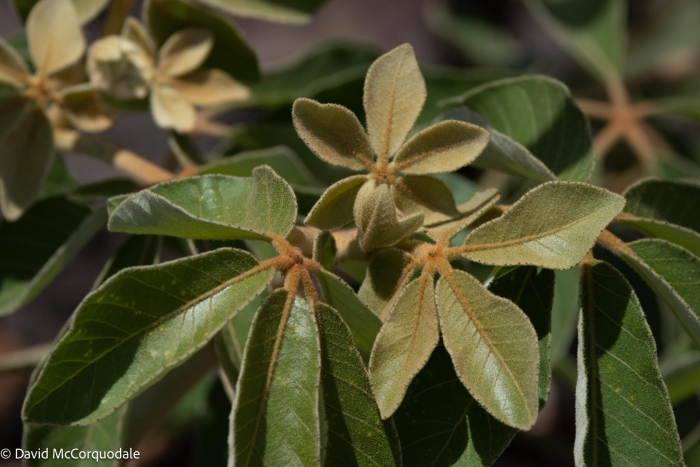Mongongo Tree
(Schinziophyton rautanenii)
Mongongo Tree (Schinziophyton rautanenii)
/
/

© David McCorquodale
CC BY 4.0
Image By:
© David McCorquodale
Recorded By:
Copyright:
CC BY 4.0
Copyright Notice:
Photo by: © David McCorquodale | License Type: CC BY 4.0 | License URL: http://creativecommons.org/licenses/by/4.0/ | Uploader: dbmcc09 | Publisher: iNaturalist |

























Estimated Native Range
Summary
Schinziophyton rautanenii, commonly known as the Mongongo tree or Manketti tree, is a deciduous tree native to the seasonally dry woodlands and savannas of subtropical southern Africa, including northern Namibia, Botswana, Zambia, and Zimbabwe. It is particularly adapted to hot, dry climates and is often found on wooded hills and sand dunes, associated with Kalahari sand soil-types. The Mongongo tree typically reaches a height of 49-66 feet (15-20 meters) and has a large, spreading canopy that provides valuable shade. It produces distinctive hand-shaped leaves and yellowish flowers in loose sprays, which are pollinated by wind. The flowers are not particularly showy, but the tree is well-known for its velvety, egg-shaped fruits that ripen to a rich brown color. These fruits contain edible nuts that are a staple diet for the San people and are rich in protein, fat, and minerals.
The Mongongo tree is valued for its hardy nature and the multiple uses of its nuts and wood. The nuts are high in vitamin E and are used to produce oil for skin moisturizing, especially useful in dry seasons. The lightweight and strong wood is utilized for making various items such as fishing floats, toys, and drawing boards. In cultivation, the Mongongo tree is often planted for its potential as a food crop, as well as for reforestation and soil stabilization projects. It requires full sun and well-drained soils, preferably sandy, and is drought-tolerant once established.CC BY-SA 4.0
The Mongongo tree is valued for its hardy nature and the multiple uses of its nuts and wood. The nuts are high in vitamin E and are used to produce oil for skin moisturizing, especially useful in dry seasons. The lightweight and strong wood is utilized for making various items such as fishing floats, toys, and drawing boards. In cultivation, the Mongongo tree is often planted for its potential as a food crop, as well as for reforestation and soil stabilization projects. It requires full sun and well-drained soils, preferably sandy, and is drought-tolerant once established.CC BY-SA 4.0
Plant Description
- Plant Type: Tree
- Height: 15-20 feet
- Width: 15-20 feet
- Growth Rate: Moderate
- Flower Color: Green
- Flowering Season: Spring
- Leaf Retention: Deciduous
Growth Requirements
- Sun: Full Sun
- Water: Low
- Drainage: Medium, Fast
Common Uses
Drought Tolerant, Edible*Disclaimer: Easyscape's listed plant edibility is for informational use. Always verify the safety and proper identification of any plant before consumption., Low Maintenance
Natural Habitat
Seasonally dry woodlands and savannas of subtropical southern Africa
Other Names
Common Names: Manketti Tree, Mongongo Nut, Manketti, Mogongo, Mongongo, Mongongo Tree
Scientific Names: , Schinziophyton rautanenii, Ricinodendron rautanenii, Ricinodendron viticoides, Vitex lukafuensis, Vitex lukafuensis,
GBIF Accepted Name: